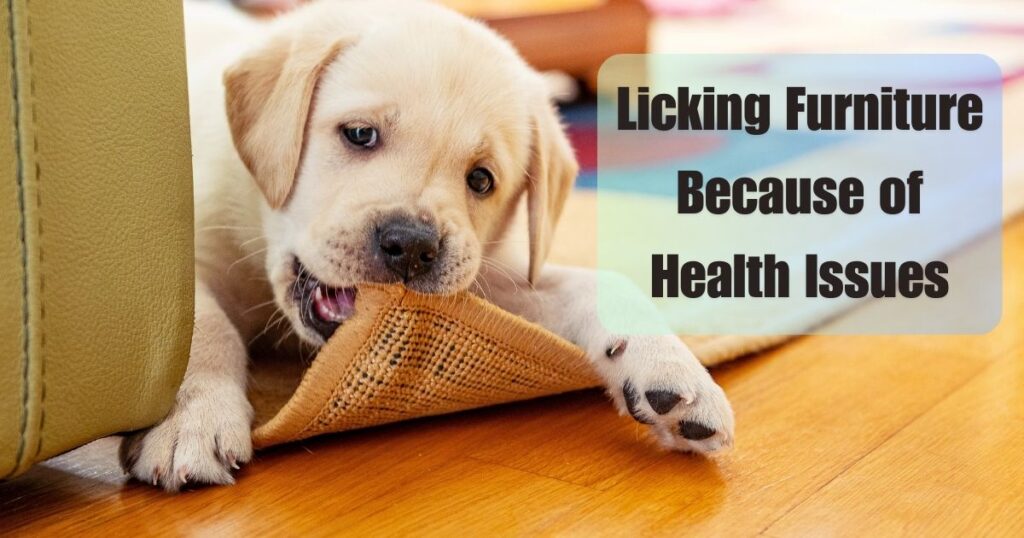If you’ve ever caught your dog obsessively licking the furniture, you’re not alone. This puzzling behavior can be linked to various reasons, from boredom to anxiety or even medical issues. Understanding why your dog licks the furniture is key to addressing the underlying cause and ensuring their well-being.
How to Manage and Reduce Licking Behavior
To manage and reduce your dog’s furniture licking, start by addressing any underlying causes like boredom or anxiety. Increase their physical and mental stimulation with regular walks, interactive toys, and engaging playtime.
Positive reinforcement is also crucial to reward your dog when they engage in alternative behaviors, steering them away from licking. If anxiety is a trigger, consider creating a calming environment or using products designed to reduce stress.
For medical concerns, such as allergies or nutritional deficiencies, consult your veterinarian to explore treatments or dietary adjustments. A well-balanced diet and proper vet care can help alleviate compulsive licking. Consistency and patience in these efforts will significantly reduce your dog’s tendency to lick the furniture, leading to a happier, healthier pet.
When to Worry About Your Dog’s Licking
If your dog’s licking behavior becomes excessive or compulsive, it’s important to pay attention. You should be concerned if the licking persists despite changes in routine or increased stimulation. Additional signs to watch for include discomfort or health issues like vomiting, diarrhea, or skin irritations accompanying the licking.
If the behavior leads to physical damage to your dog’s skin or the furniture, it’s also a red flag. In such cases, consult your veterinarian to address potential health problems or behavioral concerns early.
Dogs Licking Furniture Because They’re Bored

When dogs lick furniture out of boredom, it’s often a sign that they’re not getting enough mental or physical stimulation. Boredom driven licking is a repetitive behavior that can stem from a lack of exercise, playtime, or interactive activities.
Dogs need regular physical exercise and mental challenges to stay engaged and healthy. Providing a variety of toys, puzzle feeders, and regular walks can help alleviate boredom. Interactive play, such as fetch or tug-of-war, can also keep your dog occupied and reduce the urge to lick furniture.
If you notice your dog licking out of boredom, increasing their daily activity and enrichment can redirect their energy and attention, leading to less furniture licking.
Dogs Licking Furniture Because of Stress
Stress and anxiety can also cause dogs to lick furniture compulsively. Dogs might lick furniture as a way to soothe themselves during stressful situations, such as changes in the household, separation anxiety, or exposure to loud noises.
Identifying the stressors in your dog’s environment is crucial for addressing the behavior. Creating a calm, stable environment and establishing a consistent routine can help reduce stress. Using anxiety-relief products, such as calming chews or pheromone diffusers, may also be beneficial.
Additionally, providing a safe space where your dog can retreat during stressful times can help alleviate anxiety. If your dog’s stress-related licking persists, consider consulting a veterinarian or a professional dog trainer for tailored strategies to manage their anxiety and reduce the licking behavior.
Also Read : Gulabi Goats
Licking and Obsessive Compulsive Disorder
Licking can sometimes be a sign of Obsessive Compulsive Disorder (OCD) in dogs, a condition characterized by repetitive, compulsive behaviors. Dogs with OCD may lick excessively as a way to cope with stress or anxiety, which becomes a persistent habit.
This behavior can escalate, leading to skin issues or damage to household items. Identifying OCD involves observing if the licking is persistent and out of proportion to typical behavior. If you suspect your dog has OCD, consult a veterinarian or a veterinary behaviorist.
They can provide a proper diagnosis and recommend treatment options, which may include behavioral modification techniques, environmental enrichment, and, in some cases, medication to manage anxiety and reduce compulsive behaviors. Early intervention is key to improving your dog’s quality of life.
Licking Furniture Because of Health Issues

Licking furniture can sometimes indicate underlying health issues in dogs, such as gastrointestinal problems, allergies, or nutritional deficiencies. Dogs may lick furniture to soothe discomfort or due to unusual cravings caused by these health concerns.
For instance, gastrointestinal issues can lead to excessive licking as a way to self-soothe, while allergies might cause skin irritations that prompt licking. Nutritional deficiencies can also drive dogs to lick objects in an attempt to address unmet dietary needs.
If you notice persistent furniture licking accompanied by other symptoms, consult your veterinarian to rule out or address any health issues. Proper diagnosis and treatment are essential to resolving the behavior and ensuring your dog’s well being.
Figuring Out Why Your Dog is Licking Furniture
why your dog is licking furniture involves observing their behavior and identifying potential causes. Here’s how to pinpoint the reason:
- Boredom: If your dog is left alone for long periods or lacks stimulation, licking furniture can be a sign of boredom.
- Stress or Anxiety: Dogs might lick furniture as a coping mechanism during stressful situations or changes in their environment.
- Health Issues: Licking could indicate gastrointestinal problems, allergies, or nutritional deficiencies. Persistent licking might be linked to discomfort or cravings.
- Habitual Behavior: Sometimes, licking becomes a compulsive habit that develops over time.
Canine Body Language
Pay attention to your dog’s body language to understand their licking behavior better:
- Relaxed Posture: If your dog seems calm while licking, it might be a sign of boredom or comfort-seeking.
- Pacing or Restlessness: Signs of anxiety or stress can include pacing, restlessness, or excessive licking.
- Physical Discomfort: Look for signs of discomfort or irritation in their skin or mouth area, which may suggest health issues.
Observing these cues will help you identify the root cause of the behavior and take appropriate action.
Conclusion:
Why your dog licks furniture is crucial for addressing the behavior effectively. Whether it’s due to boredom, stress, health issues, or a compulsive habit, identifying the root cause allows you to take appropriate steps to help your dog. By observing their body language and making necessary changes, such as increasing stimulation or seeking veterinary advice, you can improve their well-being and reduce unwanted licking. A proactive approach ensures a healthier, happier environment for both you and your furry friend.







